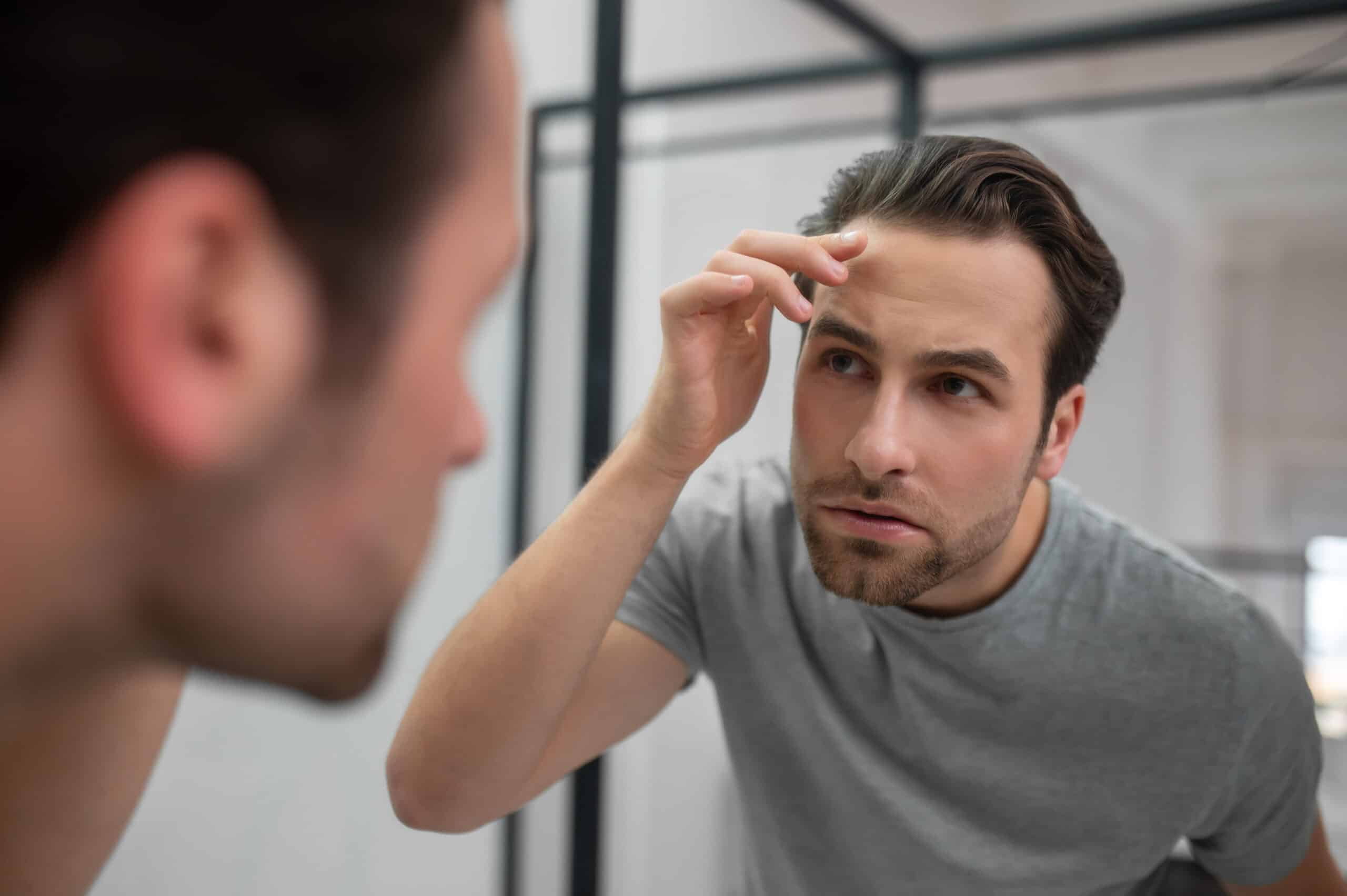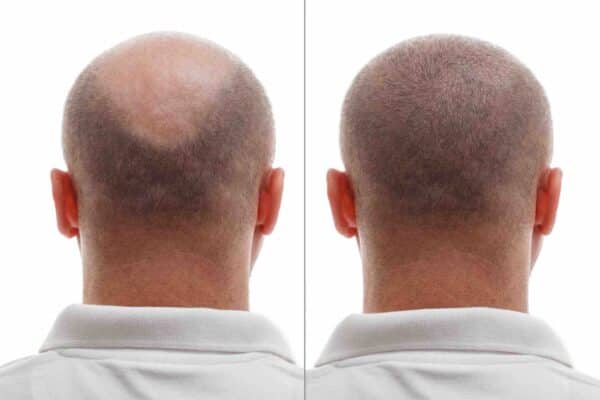Medical condition
Hair Loss


What Causes Hair loss?
Hair loss can occur due to various reasons, including:
- Decrease in the growth phase of the hair cycle. I.e., alopecia areata (Autoimmune disease)
- Increased shedding of hair during the resting phase of the hair cycle. I.e., weight loss, childbearing, stress.
- Hair shaft abnormalities
- Inflammatory skin diseases
- Male and female pattern hair loss: This is the most common hair loss type Dr. Tina treats. This type of hair loss involves the conversion of thick terminal hairs into thin vellus hairs, resulting in gradual thinning and balding in specific patterns.
Both males and females can experience hair loss. The patterns and causes of hair loss may vary between genders, but it is a common concern for both. It’s important to note that some types of hair loss are temporary and can be reversed, while others may be permanent.
Key Information
What are the common types of hair loss?
Androgenetic Alopecia (male and female-pattern baldness)
This hereditary condition in men typically results in a receding hairline and balding at the crown.
Alopecia Areata
This is an autoimmune disorder where the immune system mistakenly attacks hair follicles, leading to hair loss. It often presents as round, smooth patches on the scalp or other parts of the body.
Traction Alopecia
Caused by repeated pulling or tension on the hair, usually due to tight hairstyles like braids, ponytails, or extensions. It can lead to hair loss, especially along the hairline and temples.
Telogen Effluvium
A temporary condition where a significant number of hair follicles are pushed into a resting phase prematurely. It can be triggered by stress, illness, surgery, or hormonal changes, resulting in diffuse hair thinning.
Understanding the specific type of hair loss is crucial for determining the appropriate treatment approach.
Hair Loss in Different Age Groups
Hair loss can occur at various stages of life, and the causes and characteristics may vary across different age groups.
Hair Loss in Teenagers
Hormonal changes during puberty, stress, poor nutrition, and certain medical conditions.
Hair Loss in Young Adults (20s & 30s)
Genetic predisposition, hormonal fluctuations, stress, and lifestyle factors.
Hair Loss in Middle-Aged Adults (40s & 50s)
Continued effects of genetic predisposition, hormonal changes (menopause in women), and environmental factors.
Hair Loss in the Elderly (60s & beyond)
Aging, hormonal changes, reduced blood flow to the scalp, and medications.
It's important to note that while some hair loss is a natural part of aging, excessive or sudden hair loss may indicate an underlying issue.
Psychological Impacts of Hair Loss
Hair loss can have a profound psychological impact, diminishing self-esteem and contributing to negative body image. Social anxiety may arise as individuals fear judgment and scrutiny from others. The emotional toll can extend to personal relationships, potentially causing strain and affecting overall well-being.
If you are experiencing significant or persistent hair loss, book a consultation with Dr Tina Fang to determine the underlying cause and explore appropriate treatment options.
What Are The Causes of Male Pattern Baldness (MPHL)?
- Genetic
- Hormone - dihydrotestosterone (DHT)
What Are The Causes of Female Pattern Hair Loss (FPHL)?
- Genetic predisposition
- Hormonal changes, including fluctuations in androgen levels
- Aging
- Medical conditions such as polycystic ovary syndrome or thyroid disorders
- Certain medications
- Excessive hairstyling practices that can damage the hair follicles
- Stress
- Nutritional deficiencies
What are the treatments of Male pattern hair loss (MPHL)?
- Follicular Unit Extraction (FUE) is a surgical technique used for treating hair loss, particularly in cases of male pattern baldness. It is a minimally invasive procedure that involves the individual extraction of hair follicles from the donor area (typically the back or sides of the scalp) and their transplantation to the areas experiencing hair loss.
- Topical minoxidil is a commonly used treatment for hair loss, particularly in cases of androgenetic alopecia (male pattern baldness or female pattern hair loss). It is available over the counter in various strengths, typically as a solution or foam, and is applied directly to the scalp.
- 5-alpha-reductase inhibitors: Oral medication used to treat hair loss, specifically in cases of male pattern baldness. It works by blocking the conversion of testosterone to dihydrotestosterone (DHT), a hormone that contributes to hair loss. It is most effective in the early stages of hair loss and needs to be taken daily. Common side effects include decreased libido and sexual function.
- Regenerative medicine treatments, such as Platelet-Rich Plasma (PRP) and Regenera Activa, have gained attention as a new trend in treating androgenic alopecia, also known as male pattern baldness or female pattern hair loss. These treatments aim to stimulate hair growth and improve hair density by utilizing the regenerative properties of platelets or regenerative cells obtained from the patient's own body. While there is anecdotal evidence and some preliminary research suggesting their potential benefits, further scientific studies are still needed to establish their efficacy, determine the optimal treatment protocols, and evaluate long-term results.
What are the treatments of Female pattern hair loss (FPHL)?
- Minoxidil solution: Minoxidil has been found to be effective in slowing down or stopping the progression of hair loss in FPHL.
- Hormonal treatment: Oral medications that block the effects of androgens (male hormones) are sometimes used to treat FPHL. These may include spironolactone, cyproterone, finasteride, and flutamide. Hormonal treatment can help in improving hair growth, reducing shedding, and increasing hair density.
- Combination therapy: Some studies have shown that a combination of low-dose oral minoxidil (e.g., 2.5 mg daily) and spironolactone (25 mg daily) can significantly enhance hair growth, minimize hair loss, and improve hair density in FPHL.
Our goal is primarily to slow down or halt hair loss rather than achieve complete regrowth. Results can vary among individuals, and it may take at least six months of continuous treatment before assessing the benefits. Long-term treatment is usually necessary to maintain the positive effects.

WHICH TREATMENTS ARE AVAILABLE?
Book in for a skin consultation with Dr Tina for an individualised hair restoration treatment plan. Your best hair treatment solution will often depend on your age, gender, triggers and causes of your condition.
Dr Tina can advise on a combination including:
- Follicular Unit Extraction (FUE)
- Topical minoxidil
- 5-alpha-reductase inhibitors
- Regenerative medicine treatments
- Minoxidil solution (FPHL)
- Hormonal treatment (FPHL)
- Combination therapy (FPHL)
Aftercare Instructions for Hair Loss
Lorem ipsum dolor
Begin your journey now
Expert care and personalised treatment plans with Dr Tina Fang
Call us on 07 3472 7477 or simply book an appointment

